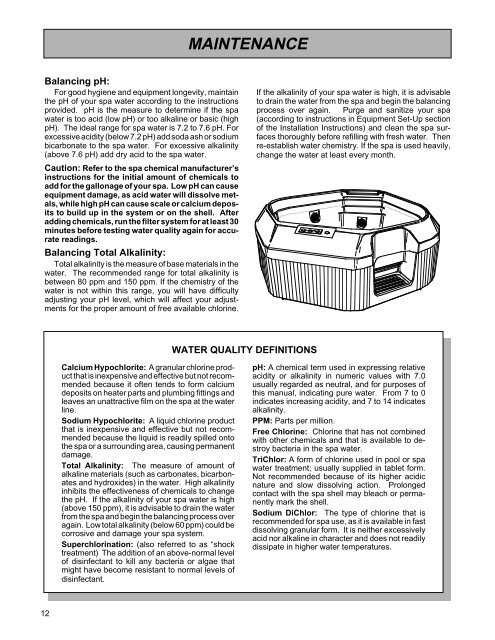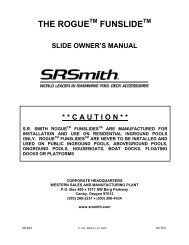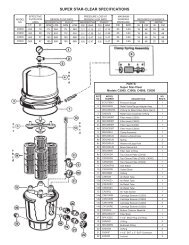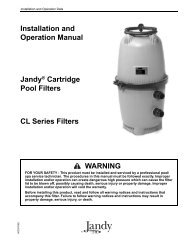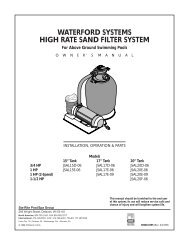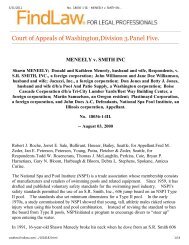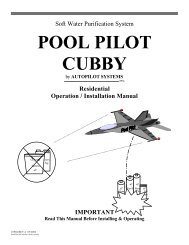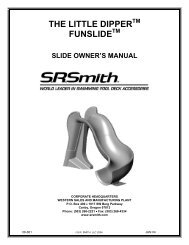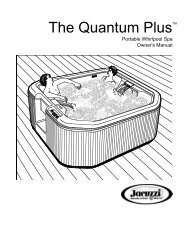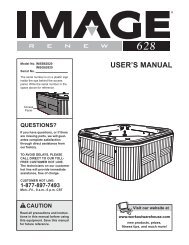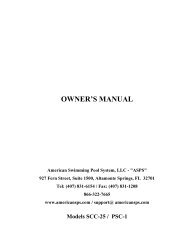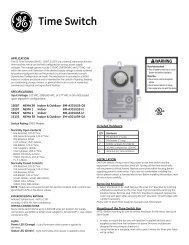You also want an ePaper? Increase the reach of your titles
YUMPU automatically turns print PDFs into web optimized ePapers that Google loves.
MAINTENANCEBalancing pH:For good hygiene and equipment longevity, maintainthe pH of your spa water according to the instructionsprovided. pH is the measure to determine if the spawater is too acid (low pH) or too alkaline or basic (highpH). The ideal range for spa water is 7.2 to 7.6 pH. Forexcessive acidity (below 7.2 pH) add soda ash or sodiumbicarbonate to the spa water. For excessive alkalinity(above 7.6 pH) add dry acid to the spa water.Caution: Refer to the spa chemical manufacturer’sinstructions for the initial amount of chemicals toadd for the gallonage of your spa. Low pH can causeequipment damage, as acid water will dissolve metals,while high pH can cause scale or calcium depositsto build up in the system or on the shell. Afteradding chemicals, run the filter system for at least 30minutes before testing water quality again for accuratereadings.Balancing Total Alkalinity:Total alkalinity is the measure of base materials in thewater. The recommended range for total alkalinity isbetween 80 ppm and 150 ppm. If the chemistry of thewater is not within this range, you will have difficultyadjusting your pH level, which will affect your adjustmentsfor the proper amount of free available chlorine.If the alkalinity of your spa water is high, it is advisableto drain the water from the spa and begin the balancingprocess over again. Purge and sanitize your spa(according to instructions in Equipment Set-Up sectionof the Installation Instructions) and clean the spa surfacesthoroughly before refilling with fresh water. Thenre-establish water chemistry. If the spa is used heavily,change the water at least every month.WATER QUALITY DEFINITIONSCalcium Hypochlorite: A granular chlorine productthat is inexpensive and effective but not recommendedbecause it often tends to form calciumdeposits on heater parts and plumbing fittings andleaves an unattractive film on the spa at the waterline.Sodium Hypochlorite: A liquid chlorine productthat is inexpensive and effective but not recommendedbecause the liquid is readily spilled ontothe spa or a surrounding area, causing permanentdamage.Total Alkalinity: The measure of amount ofalkaline materials (such as carbonates, bicarbonatesand hydroxides) in the water. High alkalinityinhibits the effectiveness of chemicals to changethe pH. If the alkalinity of your spa water is high(above 150 ppm), it is advisable to drain the waterfrom the spa and begin the balancing process overagain. Low total alkalinity (below 60 ppm) could becorrosive and damage your spa system.Superchlorination: (also referred to as “shocktreatment) The addition of an above-normal levelof disinfectant to kill any bacteria or algae thatmight have become resistant to normal levels ofdisinfectant.pH: A chemical term used in expressing relativeacidity or alkalinity in numeric values with 7.0usually regarded as neutral, and for purposes ofthis manual, indicating pure water. From 7 to 0indicates increasing acidity, and 7 to 14 indicatesalkalinity.PPM: Parts per million.Free Chlorine: Chlorine that has not combinedwith other chemicals and that is available to destroybacteria in the spa water.TriChlor: A form of chlorine used in pool or spawater treatment; usually supplied in tablet form.Not recommended because of its higher acidicnature and slow dissolving action. Prolongedcontact with the spa shell may bleach or permanentlymark the shell.Sodium DiChlor: The type of chlorine that isrecommended for spa use, as it is available in fastdissolving granular form. It is neither excessivelyacid nor alkaline in character and does not readilydissipate in higher water temperatures.12


